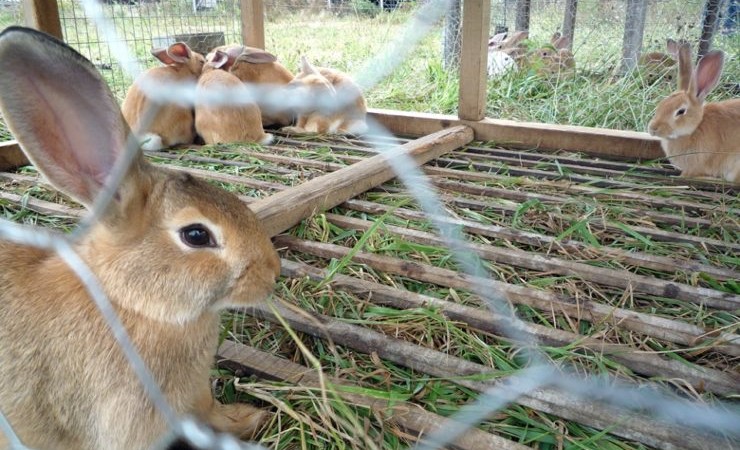

Many livestock owners are already familiar with the principles of rotational grazing. Rabbit owners who are just starting to think about keeping their rabbits on pasture, may not be as familiar with these principles. In general, rotational grazing keeps a relatively high density of animals on a small piece of ground for a very short time. Then those animals are moved to a new piece of ground.
For rabbits in particular, each new patch of ground is interesting enough and tasty enough, that their digging behaviors are minimized because naturally, Rabbits will dig into any type of soil. Additionally, different pen designs may make it difficult or impossible to dig, thus eliminating one of the major challenges in keeping rabbits on pasture.
For rabbits on pasture, we can put a layer of fencing along the pen floor, to completely enclose the pen. This approach is excellent if the ground is uneven, the grass is short, and the rabbits are large enough not to squeeze through gaps in the floor where the grass comes through.
Various fence types which have openings up to 2″ or even 4″ in size, can work well with this approach. The one major disadvantage is that movement of the pen’s bottom along the ground can sometimes flatten the grasses.
The fence openings and grass height will determine how easily the grass can come through the openings, and or how easily the rabbits can eat through the openings. The larger the opening, the more easily the rabbits can eat through it. But of course the openings should not be so large that the rabbits can start to dig and then squeeze through. When building such pens, owners will need to use a relatively large gauge wire, at least 14g, to ensure the wire is strong enough to hold a rabbit’s weight, and large enough in diameter that the rabbit can’t bite through it. Chicken wire does not work well for this purpose, because it’s too lightweight. It will readily tear when moving, it’ll rust through very quickly on even slightly damp ground, and the rabbits can bite through it.
Using any of these methods, rabbits on pasture can offer a lot of advantages. The rabbits are out in the fresh air, their urine and manure is applied directly to the soil, they get fresh grass as part of their daily diet, and issues with a buildup of smell, disease organisms, manure and hair are all minimized or eliminated.
As the does get ready to kindle and produce litters, they are to be pulled out, put in small pens just long enough to kindle and bond with the kits, then put them outside again in separate grassy pens away from the adults. Others farmers will put their pregnant does in mobile pens and include nesting boxes right in the pens. With either approach, the pens either need to be big enough that no one area becomes overgrazed, or the pens need to be moved to new ground before old ground becomes overgrazed and/or muddy and sodden. With both approaches, the kits then get the benefit of spending time on clean ground and eating fresh browse even before they are weaned.
Rabbits on pasture do require some additional consideration to avoid problems. To start with, having rabbits on pasture in direct sunlight can lead to overheating. Shade absolutely must be provided. On particularly hot, dry days, it may also be a good idea to provide fans or misters out in the pens. Or bring them into cooler indoor areas during the day and let them graze at night.
Rabbits also do not tolerate wet conditions. During the cool and damp weather, one needs to cover the pens sufficiently to provide protection against both direct and wind-driven rainfall. Pens which include wet areas need to be fenced off, or mobile pens need to be kept in well-drained areas.
Lactating does and growing kits demand the very highest nutrients from their pasture. If the pasture quality cannot meet those needs, they will weaken and die without supplementation. Conversely, non-pregnant, non-lactating does and infrequently non-breeding bucks can be maintained on less nutrient-rich pasture.
Overly rich pasture might lead them to gain too much weight, while thin or poor pasture might be nutritionally deficient. So pasture resources must be assessed and monitored over time. Just as with other species, field and climate conditions must be monitored, and protection/supplementation provided as needed, to optimize the practice of keeping rabbits on pasture.
 Contact Jaguza Support
Contact Jaguza Support